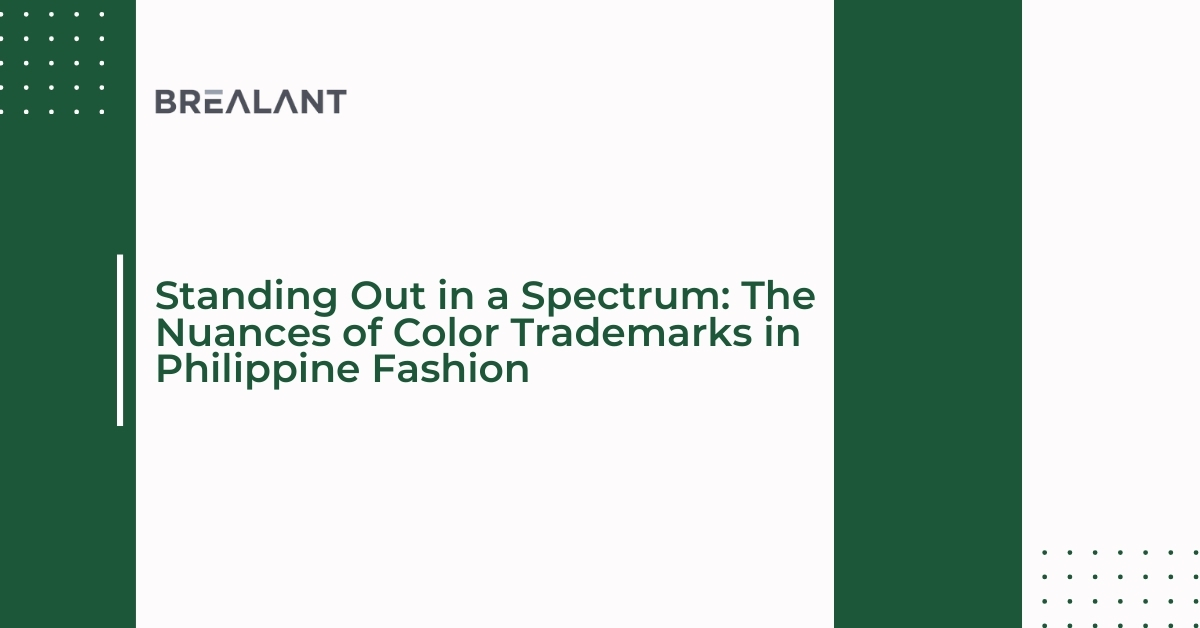The fashion industry thrives on visual identity. From the iconic red soles of Christian Louboutin to the instantly recognizable Tiffany & Co. blue, colors have become powerful branding tools. But can a single color, devoid of logos or designs, be trademarked in the Philippines? The answer, like a well-tailored suit, is more nuanced than a simple yes or no.
The Challenge of Color Trademarks
While Philippine law (Republic Act No. 1401, also known as the Intellectual Property Code) acknowledges color as a potential trademark subject, securing such a trademark is significantly more complex than registering words, logos, or symbols. Here’s why:
- Distinctiveness: A color must be distinctive in the marketplace, meaning it has acquired secondary meaning. In simpler terms, consumers must associate the color with a specific brand, not just the product’s inherent qualities. For example, the vibrant “Tiffany Blue” has become synonymous with the luxury jewelry brand, not just a shade associated with elegance.
- Functionality: Colors cannot be trademarked if they serve a purely functional purpose. Imagine a company trying to trademark black for all formal wear – this wouldn’t be allowed, as black is inherently linked to formality.
Statistics that Speak Volumes
According to a 2022 study by the United States Patent and Trademark Office (USPTO), only a small percentage (less than 2%) of color trademark applications are successful. This statistic reflects the high burden of proof required to demonstrate that a color has achieved secondary meaning.
Case Studies: Lessons Learned
Philippine courts still need to deliver a definitive judgment on color trademarks. However, we can glean valuable insights from international cases:
- The Louboutin Red Sole Saga: Christian Louboutin famously attempted to trademark the red lacquered soles of their high heels. While successful in some jurisdictions (think Europe), the brand faced challenges in the U.S., where courts ruled the red sole was a functional element (distinguishing the sole from the shoe itself) unless used in combination with a specific red shade and the Louboutin brand [Louboutin v. Yves Saint Laurent, 690 F.3d 1020 (2nd Cir. 2012)].
- The Tiffany vs. Costco Teal Battle: Tiffany & Co. clashed with Costco over using a similar blue shade for shopping bags. Here, Tiffany’s long-standing use, extensive marketing, and consumer recognition of the color linked to their brand helped secure a favorable verdict [Tiffany and Co. v. Costco Wholesale Corp., 161 F. Supp. 2d 1124 (S.D.N.Y. 2001)].
Strategies for Success: Building a Strong Case
So, how can Philippine fashion brands increase their chances of successfully trademarking a color? Here are some key strategies:
- Extensive Brand Building: The longer and more consistently a brand uses a specific color in its marketing, advertising, and product design, the stronger the case for secondary meaning.
- Consumer Recognition Studies: Conducting surveys or market research to demonstrate consumer association of the color with the brand can be powerful evidence.
- Limited Color Palettes: Focusing trademark efforts on a specific shade within a broader color range might be more achievable than a generic color like red or blue.
- Combined Trademarks: Consider combining the color with a logo or design element for a stronger trademark application.
The Road Ahead: A Colorful Future for Philippine Fashion
While trademarking a single color in the Philippines remains an uphill battle, it’s not impossible. By understanding the legal challenges and implementing strategic brand-building techniques, Filipino fashion houses can leverage the power of color to create a truly distinctive identity in the competitive fashion world. Remember, a well-protected brand color can be valuable, setting your label apart from the crowd and ensuring consumers recognize your unique style.
Brealant Inc. Can Help You Trademark Your Signature Shade
The world of color trademarks in fashion is a vibrant tapestry woven with distinctiveness, functionality, and brand strategy threads. While securing a color trademark in the Philippines presents challenges, it’s possible.
We can be your trusted intellectual property partner, can help you navigate the complexities of color trademarking. Our team of legal experts possesses the knowledge and experience to:
- Evaluate the distinctiveness of your chosen color in the marketplace.
- Develop a comprehensive brand-building strategy to strengthen your color association.
- Craft a compelling trademark application that highlights the unique value of your color.
- Guide you through the trademarking process, ensuring a smooth and successful journey.
Don’t let your signature shade fade into the background. Contact us today for a consultation and let us help you secure the legal protection your brand deserves. Together, we can ensure your color story has a happy ending.

